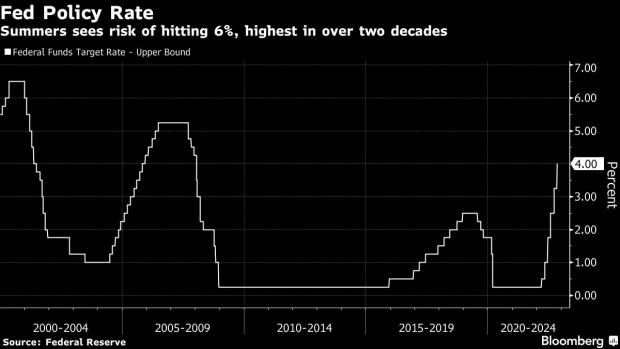Nov 4, 2022
Summers Sees Risk Fed Needs to Hike Past 6% to Curb Inflation
, Bloomberg News

(Bloomberg) -- Former Treasury Secretary Lawrence Summers sees a risk of the Federal Reserve needing to boost interest rates to 6% or higher to bring inflation under control, given a US economy that is still running strong.
“I’m moving upwards my view on the possibilities for the terminal rate,” Summers told Bloomberg Television’s “Wall Street Week” with David Westin, referring to the end-point for the Fed’s rate-hiking campaign. “It’s not what I would expect but it would not surprise me if the terminal rate reached 6 or more,” he said.
Fed Chair Jerome Powell and his colleagues on Wednesday boosted their target for the federal funds rate to a 3.75% to 4% range. Powell said in his press conference that policymakers may need to lift the rate past the 4.6% level that was referenced in the Fed’s September projections for next year -- though he stopped short of specifying any new peak.
Nomura Holdings Inc. currently has the highest forecast for the Fed’s peak rate in Bloomberg surveys, at a 5.5% to 5.75% range for May of next year.
Summers, now a Harvard University professor and a paid contributor to Bloomberg Television, said that the October jobs report published earlier Friday underscored that “still, the economy is looking quite strong.”
“The good news is the economy looking robust, the bad news is not much evidence of inflation restraint yet in train,” Summers said.
The former Treasury chief also blasted analysts arguing that most of the inflation the US is now seeing is a result of disruptions on the supply side of the economy -- which the Fed cannot directly address through rate hikes -- and not the demand side -- which is more directly influenced by the borrowing costs that monetary policymakers oversee.
Mark Zandi, the chief economist at Moody’s Analytics, has calculated that almost 60% of the 8.2% annual increase in the consumer price index in October was due to “supply-side drivers,” with only 28% identifiable as propelled by the demand side.
“I have to respectfully say that I can’t really see a lot of logic in the views that Zandi and those like him are expressing,” Summers said. “The people who push the supply-side arguments are kind of analytically confused.”
Summers highlighted that nominal gross domestic product, which is unadjusted for inflation, has surged. This showcases that price pressures have been demand driven, he said.
“The way you tell a supply shock from a demand shock: both of them raise prices, but when there’s a supply shock, quantity falls. When there’s a demand shock, output is strong, and output has been very strong,” Summers said.
©2022 Bloomberg L.P.






